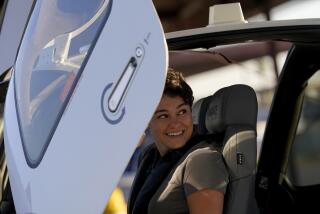Midwest Flight School Spans the World : Illinois: Airgo has trained hundreds of pilots at Centralia Municipal Airport, many of them foreign students. They say they learn quicker here, and it costs them less.
- Share via
CENTRALIA, Ill. — Dhananjay Natu came all the way from India to learn to fly American-style, mortgaging his apartment to pay the $18,000 tuition and leaving his fiancee behind for a year.
It’s worth it, Natu says, because he can get more done at Airgo Inc.’s flying school than he could in twice the time back home in Bombay--and for about a third of the price.
“Hardly we have two aircraft per flying school there, and the number of students who wish to fly [is often] more than 20,” the 27-year-old former manager said. “So we hardly got an hour or two in a week to fly. By the time you take your lessons, go to the sky and start recollecting what you’ve been taught, it’s time to land.”
Airgo, which has trained hundreds of pilots at Centralia Municipal Airport for more than 20 years, is seeing many foreign students like Natu at its school in the rolling prairies and cornfields of southern Illinois.
The school, with a fleet of 18 planes, graduates 80 to 100 students in a typical year, owner Leslie Erb said.
This year’s student body includes five students from Indonesia, two from India, two more from Bangladesh, and several others from Portugal, France, Britain, Andorra and New Zealand.
Other aviation schools across the country also are seeing a rise in the number of foreign students. Some, like Airgo, have been aggressively marketing their programs overseas.
Foreign students are “clearly the fastest-growing section of flight training in America today,” said Jim Coyne, president of the National Air Transportation Assn.
Coyne estimated there’s been at least a 10% annual growth over the last five years in foreigners learning to fly in the United States. Today, about 15% of the enrollment is foreign, he said, and this year’s enrollment likely will increase 25% over last year.
One big reason is that the more than 2,000 U.S. flying schools are much cheaper than their overseas counterparts.
Stephen Ash, a native of England who is Airgo’s chief instructor, said a 250-hour commercial multi-engine rating would cost about $90,000 in his home country, while Airgo offers the same license for $18,000. That includes six months’ accommodations and pickup and drop-off in St. Louis. The rating is a prerequisite to a job with an airline.
Ash, 33, came to Airgo four years ago to learn to fly. Now, 1,500 flying hours later and married to a Centralia woman, Ash says the multicultural environment is one of the best things about his job.
“We all share the same love, and that’s to be a pilot,” Ash said. It doesn’t matter where you come from or what your culture is. The one bond we all share is a love of flying.”
He said Indonesia probably will be a hot market for flying schools like Airgo because that country wants to put more of its own native pilots in the cockpit, replacing the British, Americans and Australians they rely on now.
Paul Symarmata, a 23-year-old from Indonesia who has been in Centralia only about three months, recalled with a wince how students are taught to fly back home.
“You do something wrong, and pow!” said Symarmata, punching his palm. “The instructor smacks you hard.”
Getting a commercial license in Indonesia also would take about four times longer than at Airgo, added countryman Bagus Nugroho, 19.
Desmond Campbell gave up a lucrative job as a computer engineer in London to come to Centralia and pursue his dream of being a commercial pilot. Two months later, he’s already got a nickname, “The Lawn Mower,” because he strayed off the runway and into the grass during a landing.
“I’ve always thought of becoming a pilot,” said Campbell, 27. “Now I have the money, so I better do it now before I blow it on something stupid.”
More to Read
Sign up for The Wild
We’ll help you find the best places to hike, bike and run, as well as the perfect silent spots for meditation and yoga.
You may occasionally receive promotional content from the Los Angeles Times.





